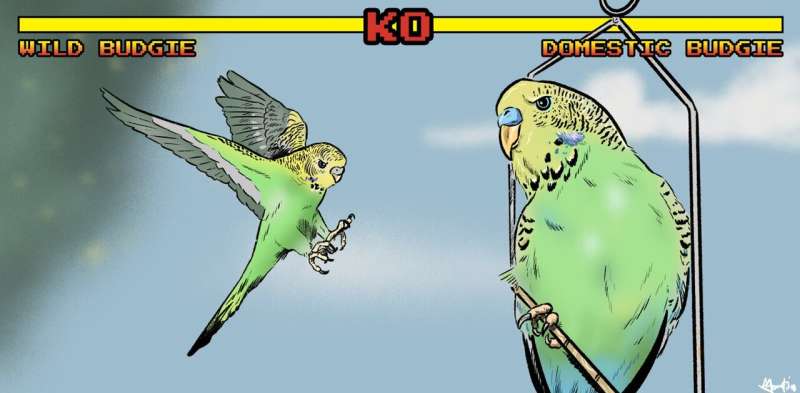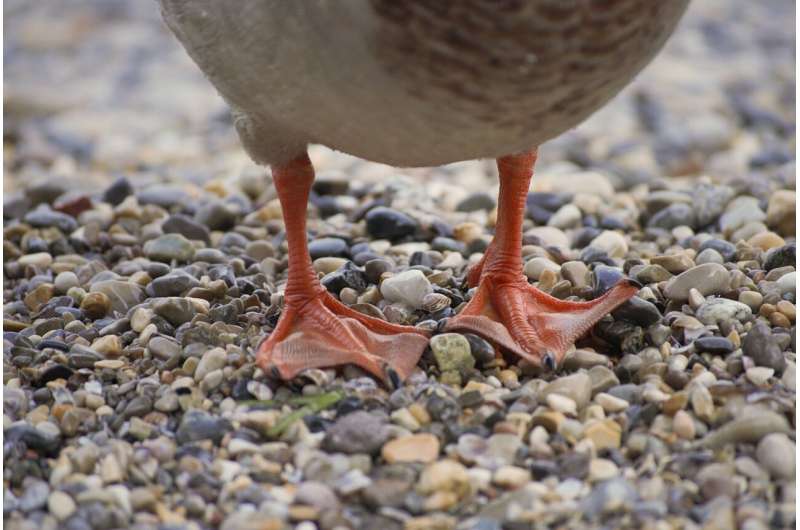In a fight between a wild and a domestic budgie, whose feathers would fly?

Who would have thought the budgerigar, Australia's most petite parrot and a denizen of our arid and semi-arid inland, would become the most popular pet bird in the world?
The budgerigar's world domination began in 1840 when British ornithologist John Gould returned to England from the Australian colonies. With him were two budgerigars which had survived the months at sea.
As Gould later wrote in a letter to a relative, the pair were "in exuberant voice and the most animated cheerful little creatures you can possibly imagine."
Gould showed the birds off at scientific meetings and visits to stately homes, attracting much interest and envy.
By the 1860s, collectors had discovered many of the birds' breeding grounds across Australia's interior and the holds of ships from Adelaide to Europe were often filled with thousands of budgies. In the 1880s, fanciers in England and Europe were breeding budgerigars and budgie farms were producing vast numbers for sale as pets.
After 150 years of selective breeding in captivity, including as an exhibition bird, the domestic budgie would now be almost unrecognizable to its wild cousin. So in the unlikely event of a confrontation between the two, whose feathers would fly?
Battle of the budgerigars—in the wild
Outside captivity, the wild budgie would defeat its domesticated doppelganger without ruffling a feather. Wild budgies are swift and agile, with a slightly forward-leaning posture always ready to take off. By comparison, pet budgies are slower and less athletic—particularly show budgies, which can barely fly and are bred to stand upright.
Show budgies do have one factor that could possibly work in their favor: size. They're bred big and bulky, weighing in at about 55 grams, compared to the more slender wild and pet budgies at about 30 grams. But given show budgies are bred to be placid, they're unlikely to throw their supersized weight around.
And while wild budgies are smaller than a show or pet budgie, their ability to dodge a predator is considerable—especially when they are in a coordinated, wheeling flock.

In the 1870s in South Australia, for example, wild budgies even managed to dodge gun club shooters. Club members complained budgies were too small and swift, and hard to follow because their color blended with the local vegetation. Eventually they abandoned them for pigeons.
But what of the pet budgies' purported psychic powers—could they be used to outwit an opponent on the battlefield?
In late Victorian London, budgerigars were popular tellers of fortunes. Their keepers, often migrant women, earned a penny by getting their budgie to choose a predictive note from among many. Clairvoyant budgies can still be found eking out a living in Iran, Mexico, China and elsewhere.
Of course, there's no evidence to suggest pet budgies can actually predict the future. In fact in a battle outside captivity, wild budgies are more likely to display psychic-like prowess. Flocks of wild budgies have an uncanny ability to find distant water and fresh seeding grasses, traveling far as the country dries out.
The budgie battle continues—in captivity
Given domesticated budgerigars don't survive long in the wild, the most likely confrontation would occur in captivity.
Individual budgies—particularly females—can be territorial, particularly when breeding. So the most likely squabble would occur when a wild budgie was caged with a female pet budgie.
In captivity, the odds of victory are stacked against the wild budgie. Away from the safety of the flock, it would be timid and nervous, in contrast to its domesticated cousin which is likely to be confident, cheeky and attention-seeking.
The pet might bully the wild bird by raising her wings, hissing, biting, chasing or picking at the other bird's feathers, as well as keeping it from food and drink.
Pet budgies have another advantage tucked into their feathers: the gift of the gab. The respiratory system of all budgerigars allows an unbroken stream of chatter or song. Wild birds apparently do not mimic, however pet budgies—particularly males—can be taught to mimic human speech.
A baby-blue budgie named Puck holds the world record for vocabulary: 1,728 words. Like most clever budgies, he not only mimicked but created his own phrases and sentences. Such a champion talker would simply out-prattle a wild opponent.
And what if the confrontation took place in the show ring or pet shop, where the battle is for the judge's/buyer's eye? Sadly for the wild budgie, its sleek, standard green and gold plumage wouldn't cut it in this competition class.
Pet budgies come in myriad colors except red and black. They also bear many variations in markings—with names such as clearbody, lacewing, yellowface, spangle and pied—which can occur separately or in combination.

But in the arena, show budgies are the real exhibitionists. Show budgies are selectively bred to feature bouffant hairdos. Sometimes fringed or crested, the hairdo makes the head appear larger obscures the eyes and sometimes even the beak.
Selection has also ensured that show budgies bear bright blue cheek-patches and black necklace spots of highly exaggerated size. And if that's not enough, their owners will also pluck and trim the plumage before a show.
Context counts
The native budgerigar has lived millennia of boom-bust cycles in the arid inland of Australia, a world away from the cozy domestic lives of our pet budgies.
And the hefty, extravagantly coiffed show budgie is as different from the free-living original as a chihuahua from a wolf.
So, the answer to who would win a fight between the various budgie types depends on the context. Clearly, all are fit for purpose.
Provided by The Conversation
This article is republished from The Conversation under a Creative Commons license. Read the original article.![]()


















